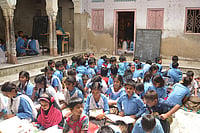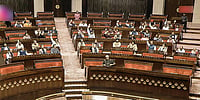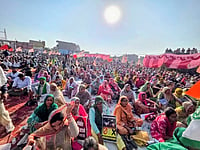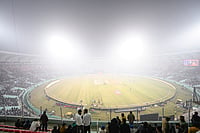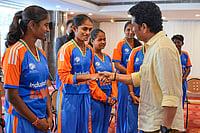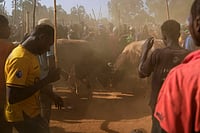On the evening of September 24, Prime Minister Atal Behari Vajpayee was in his presidential suite on the 51st floor of the New York Palace hotel when national security advisor Brajesh Mishra and joint secretary, pmo, P.S. Raghavan walked in. They had with them the text of the speech Pakistan President Gen Pervez Musharraf had delivered at the United Nations that very afternoon. Large parts of the speech were heavily underlined. These referred to Musharraf's comments on India and Kashmir, as also to his offer to facilitate reduction of violence in the Valley.
As Vajpayee sank into the sofa and read the speech, there was silence all around. They had all expected Musharraf to assume a strident tone. But as Vajpayee picked his way through the text, he realised Pakistani rhetoric had hit a new low. The PM was convinced he could not ignore Musharraf's remarks altogether.
What Vajpayee must have found galling was Musharraf's contemptuous reference to coercive diplomacy. "I'm glad India has stepped back from its dangerous and failed experiment in 'coercive diplomacy' last year," Musharraf had sneered.
Vajpayee decided to take a firm stance. The language, of course, should not sound unpleasant. Mishra and Raghavan came up with some formulations. Based on the draft paras, Vajpayee worked on the speech. As an official put it, "He could have spoken in many tones: sarcastic, contemptuous, light and dismissive. But he chose the high road, avoiding a slanging match." Officials do not think that Vajpayee walked into a trap at the UN. It was a conscious attempt to soberly counter Pakistan's arguments in the august body. "Last year too, we responded to Pakistan's long harangue. This year, our response was a little more than normally curt."
But even before Vajpayee delivered his speech, Musharraf had convened a press conference to hammer in a few points. Asked if there would be a meeting between him and Vajpayee during the SAARC summit in Islamabad early January, Musharraf was blunt to the point of being rude. "I am not at all keen on meeting him. If he thinks that only I need to show keenness, and he is going to reject, I won't give him the pleasure. I'm not interested."
This intemperate remark, and Vajpayee's speech, made it obvious to all that the peace process he had initiated five months ago was grinding visibly to a halt. No wonder then that the first question Vajpayee fielded as he landed in New Delhi was: where was the peace process involving India and Pakistan headed? Vajpayee replied there had been a setback but the process had to go on.
Government officials, though, have been more pointed. "It has just hit a speed breaker," said an official. Another added: "Musharraf wants to buy treasury bonds with fake currency. Why is it that when we respond to him, doubts are raised about the peace process continuing? How come no one questions Musharraf for vitiating the atmosphere?"
Senior officials are tight-lipped about Vajpayee's trip to Islamabad for the SAARC summit, refraining from categorically commenting about it. They only say India is committed to SAARC, that the SAARC processes are distinct from the bilateral peace process. As a senior official explains, "The delicacy is: how do you separate a visit to Islamabad from the likelihood or possibility of bilateral encounters? If Pakistan moves on sapta (South Asian Preferential Trade Agreement), it would create a better atmosphere for SAARC and therefore bilateral improvement." This is the outline of the roadmap to peace from New Delhi's perspective.
Pakistani diplomats, however, have a different take on the peace process. "What peace process?" asked a diplomat rhetorically. "All that you see (resumption of bus services, upgrading ties at the high commissioner level) is just plumbing work.The leaks are being plugged, that's all."
Indian and Pakistani diplomats, however, confirm positive movement on the two offers New Delhi made to Islamabad at the time the two leaders were engaged in a verbal duel in New York. Islamabad has accepted the suggestion that the respective mission strengths be increased from the current 47 to 55, besides requesting for dates during which it could send a team to inspect the Baglihar dam in J&K. This is likely to happen this month.
Again, don't assume all is well despite the regular public display of pique. Indian officials say the process of identifying and sending the eight people to its mission in Islamabad could well take 4-5 months. There are, however, indications that the preliminary job of identifying these officials is already well under way.
Pakistani diplomats have their own take: given the 'breakneck' speed at which the peace process is moving forward, they say it could take six years before the full mission strength of 110 is achieved.
Indian diplomats justify their caution, claiming the indicators of violence in J&K—infiltration, communications networks, infrastructure to export terror—are still at robust levels. "There were 28 recorded infiltration attempts in September. It was one attempt a day," points out a senior official. "The Pakistanis are working the control levers of the violence furiously," adds another official.
In such circumstances any possibility of a sustained dialogue looks a trifle far-fetched. It could look even more incongruous as the bjp girds up for elections.
Bat-Wing Doors
It's the same old script. But with the two sides sparring, is the process a casualty? Updates

Bat-Wing Doors
Bat-Wing Doors
Published At:
MOST POPULAR
WATCH
MORE FROM THE AUTHOR
PHOTOS
×














